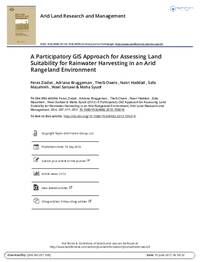A Participatory GIS Approach for Assessing Land Suitability for Rainwater Harvesting in an Arid Rangeland Environment

Authors:
The dry rangelands of West Asia and North Africa are fragile and severely degraded due to low rainfall and mismanagement of natural resources. Rainwater harvesting (RWH) interventions are used to increase soil moisture content, vegetation cover, and productivity. However, adoption of rainwater harvesting by communities is slow. To understand adoption constraints and to develop options for sustainable integration of rainwater harvesting, a benchmark watershed was established in the dry rangelands of Jordan. The objective is to develop a methodology for identifying the suitability for different rainwater harvesting interventions using participatory GIS approach and field survey. The main biophysical parameters used to assess the suitability for rainwater harvesting were slope, soil depth, soil texture, and stoniness. Criteria for each parameter were integrated and a suitability map was produced using raster-based and polygon-based analysis. To integrate biophysical and socio-economic aspects, the land tenure was superimposed with the suitability map. Options for implementing different rainwater harvesting interventions were identified with the participation of the local communities. Field investigations indicated that the applied approach helped to select the most promising fields. Within two years, four types of rainwater harvesting were implemented in the fields of 41 farmers, covering 62.9 hectares, which helped to increase water productivity (kg/m3) four folds and reducing soil erosion five folds compared to fields without rainwater harvesting. The approach showed that participatory GIS approach may be used to integrate socio-economic and biophysical criteria and facilitate the participation of farmers to introduce rainwater harvesting interventions in dry rangeland systems to mitigate land degradation.
